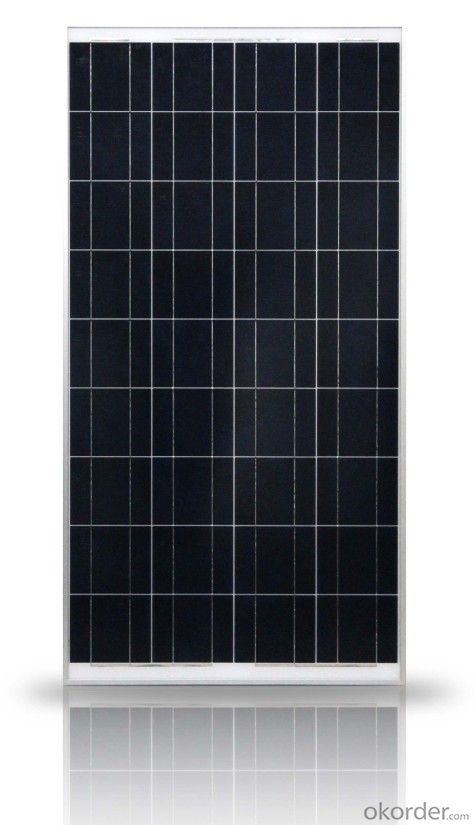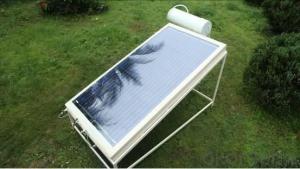Factory Directly Sale Poly solar Panel with 25 Years Warranty CNBM
- Loading Port:
- Qingdao
- Payment Terms:
- TT OR LC
- Min Order Qty:
- 10 set
- Supply Capability:
- 300000 set/month
OKorder Service Pledge
OKorder Financial Service
You Might Also Like
Polycrystalline Solar Modules
CNBM offers a range of small, medium and large polycrystalline solar modules, designed for a range of requirements.

Specifications:
Tolerance | +/-3% |
Cell | Polycrystalline silicon solar cells (156 x 156mm) |
N0. of Cells | 60 (10 x 6) |
Dimension of Modules (mm) | 1650 x 990 x 40 |
Weight (kg) | 25.5 |
Limits:
Operating Temperature | -40~+85? |
Storage Temperature | -40~+85? |
Maximum System Voltage | 1000 VDC max. |
Hail Impact | Diameter of 28mm with impact speed |
Temperature and Coefficients:
NOCT | 48C+/-2? |
Voltage temperature coefficient (%/K) | -0.35 |
Current temperature coefficient (%/K) | 0.05 |
Power temperature coefficient (%/K) | -0.45 |
Characteristics:
Model: | SGM-200P | SGM-210P | SGM-220P |
Max-power voltage Vmp (V) | 29.2 | 29.4 | 29.41 |
Max-power current Imp (A) | 6.85 | 7.14 | 7.48 |
Open-circuit voltage Voc (V) | 36.5 | 36.69 | 36.9 |
Short-Circuit Current Isc (A) | 7.28 | 7.6 | 7.93 |
Max-power Pm(W) | 200 | 210 | 220 |
Model: | SGM-230P |
Max-power voltage Vmp (V) | 29.8 |
Max-power current Imp (A) | 7.72 |
Open-circuit voltage Voc (V) | 37.31 |
Short-Circuit Current Isc (A) | 8.19 |
Max-power Pm(W) | 230 |
STC: Irradiance 1000W/m2, module temperature 25?, AM-=1.5
Poly Crystalline Solar Panels Specifications Range
Maximum Power (Pm) | Dimension | Weight | Operating Voltage (Vmp) | Operating Current (Imp) | Open Circuit Voltage (Voc) | Short Circuit Current (Isc) |
0.45W | 140x80x10mm | 0.08kg | 3.3V | 150mA | 4.6V | 160mA |
1.0W | 162x140x10mm | 0.16kg | 7.5V | 150mA | 10.3V | 160mA |
4.5W | 269x251x23mm | 0.8kg | 16.5V | 0.27A | 20.5V | 0.3A |
10W | 420.1×268.9×22.6mm | 1.92kg | 17.5V | 0.58A | 20.5V | 0.6A |
20W | 425x502x50mm | 3.0kg | 16.8V | 1.19A | 21.0V | 1.29A |
30W | 593x502x22.6mm | 3.9kg | 16.8V | 1.78A | 21.0V | 1.94A |
40W | 655x537x50mm | 5.75kg | 17.3V | 2.31A | 22.1V | 2.54A |
50W | 839x537x50mm | 6.0kg | 17.5V | 2.9A | 21.8V | 3.17A |
65W | 1111x502x50mm | 7.2kg | 17.6V | 3.69A | 22.1V | 3.99A |
80W | 1204x537x50mm | 7.7kg | 17.6V | 4.55A | 22.1V | 4.8A |
- Q:How do solar cells perform in areas with high levels of snowfall?
- Solar cells generally do not perform optimally in areas with high levels of snowfall. The accumulation of snow on the surface of solar panels can significantly reduce their efficiency by blocking sunlight and preventing the cells from generating electricity. Regular snow removal or tilting the panels at an angle can help mitigate this issue, but it may still impact their overall performance in such regions.
- Q:Can solar cells be used in farming or agriculture?
- Yes, solar cells can be used in farming or agriculture. They can be used to power various applications such as irrigation systems, electric fences, and remote monitoring systems, reducing the reliance on traditional energy sources. Additionally, solar panels can be installed on rooftops or mounted on structures to generate clean energy for on-site consumption or to be sold back to the grid, enabling farmers to save on electricity costs and contribute to sustainability efforts.
- Q:Can anybody tell me how to make a solar cell at home?
- Well, it's not very difficult to make a solar cell at home,but you do need to prepare 2 glass plates first.
- Q:Are solar cells affected by extreme temperatures?
- Yes, solar cells can be affected by extreme temperatures. High temperatures can cause the efficiency of solar cells to decrease, as excessive heat can cause an increase in resistance and reduce the voltage output. Similarly, extremely cold temperatures can also impact their performance, although to a lesser extent. It is important to note that modern solar cells are designed to withstand a wide range of temperatures, and their efficiency is typically optimized within a specific temperature range.
- Q:My son is very interested in solar cells recently, and keeps asking me about the structure of a solar cell. Can anybody help me answer that question?
- This is what I search online from Wikipedia, solar cell is an electrical device that converts the energy of light directly into electricity by the photovoltaic effect.
- Q:Can solar cells be installed on vehicles?
- Yes, solar cells can be installed on vehicles. In fact, many electric and hybrid vehicles are equipped with solar panels on their roofs or hoods to harness solar energy and supplement their power source. These solar cells help to charge the vehicle's battery and increase its overall efficiency, reducing the reliance on traditional charging methods and improving sustainability.
- Q:Can solar cells be used on backpacks or camping gear?
- Yes, solar cells can be used on backpacks or camping gear. They can be integrated into the design of backpacks or attached to camping gear to harness solar energy and convert it into electricity, allowing for convenient charging of devices or powering small electronics while on the go.
- Q:What is the lifespan of a solar cell battery?
- The lifespan of a solar cell battery can vary depending on various factors such as the quality of the battery, usage patterns, and maintenance. On average, a well-maintained solar cell battery can last anywhere between 5 to 20 years.
- Q:What is 3d solar cell? And anybody know any manufacturers?
- 3d solar cell is 3-dimensional silicon solar cell, which is is designed to maximize the conversion of sunlight into electricity.
- Q:What materials are used to make solar cells?
- Solar cells are primarily made using materials such as silicon, which is the most commonly used material, as well as other semiconductor materials like cadmium telluride, copper indium gallium selenide, and perovskite.
1. Manufacturer Overview |
|
|---|---|
| Location | |
| Year Established | |
| Annual Output Value | |
| Main Markets | |
| Company Certifications | |
2. Manufacturer Certificates |
|
|---|---|
| a) Certification Name | |
| Range | |
| Reference | |
| Validity Period | |
3. Manufacturer Capability |
|
|---|---|
| a)Trade Capacity | |
| Nearest Port | |
| Export Percentage | |
| No.of Employees in Trade Department | |
| Language Spoken: | |
| b)Factory Information | |
| Factory Size: | |
| No. of Production Lines | |
| Contract Manufacturing | |
| Product Price Range | |
Send your message to us
Factory Directly Sale Poly solar Panel with 25 Years Warranty CNBM
- Loading Port:
- Qingdao
- Payment Terms:
- TT OR LC
- Min Order Qty:
- 10 set
- Supply Capability:
- 300000 set/month
OKorder Service Pledge
OKorder Financial Service
Similar products
New products
Hot products
Hot Searches
Related keywords





























